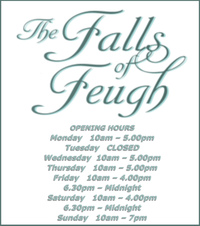


Local Sponsors
-
Falls of Feugh Restaurant & Function Suite
Bridge of Feugh, Banchory, Aberdeenshire. AB31 6NL
Award-winning chef John Chomba is pleased to welcome you to his new venture, a family-run restaurant set in a stunning location. Showcasing the best of modern British cuisine, we pride ourselves in providing great food and service in outstanding surroundings.
-
River Dee Trust & Dee District Salmon Fishery Board
River Office, Mill of Dinnet Mill of Dinnet Aboyne AB34 5LA
The River Dee is an internationally important environment for wildlife and is designated a Special Area of Conservation (SAC) for its populations of Atlantic salmon, otters and freshwater pearl mussels.
More information
Many thanks to The Falls of Feugh Restaurant & Function Suite for facilitating this camera's location and to the River Dee Trust & Dee District Salmon Fishery Board for their help in arranging its installation. The Feugh River holds the distinction of being the largest tributary to the River Dee. Originating from the Grampian Mountains within the Forest of Birse, it showcases a remarkable scenic beauty, particularly at the Bridge of Feugh, where a series of cascades grace its landscape just before it joins the Dee. A short stroll from the center of Banchory leads to the Falls of Feugh, a popular spot for observing salmon leaping. Visitors often gather on the footbridge to witness this captivating sight.
During the 1800s, turnpike roads were constructed across Scotland, and travelers were required to pay tolls for their usage. Toll houses were strategically erected with windows facing both directions of the road to capture passing travelers. A noteworthy example of a former toll house can be found at the Bridge of Feugh.The name Banchory is believed to have originated from an early Christian settlement founded by St. Ternan, who was said to have been a follower of St. Ninian. According to tradition, Ternan established his settlement on the banks of the River Dee, which later became the kirkyard of the medieval parish of Banchory-Ternan. The village and parish retained this name until the 1970s. The original Gaelic form closely resembles "Bangor," which has a similar meaning and is the site of a monastery in Northern Ireland. Relics associated with St. Ternan were safeguarded by hereditary keepers in Banchory until the time of the Scottish Reformation. Two early Christian cross-slabs have survived within or near the old churchyard on the site of the early church. One of these slabs, displaying two crosses incised on a weathered pink granite surface, is integrated into a corner of the mort house in the churchyard. The other slab, featuring a ringed cross in relief, is built into the wall facing the main road outside the churchyard.Glen O'Dee Sanatorium holds the distinction of being the first sanatorium constructed in Scotland. Designed by George Coutts of Aberdeen, it opened its doors in 1900. The building predominantly consisted of timber, with a central tower crafted from Hill of Fare granite. All rooms boasted balconies and verandas that faced south, overlooking the river. Access corridors ran along the north side of the structure. A recreation pavilion was later added to the southeast, situated below the dining hall. Tragically, on October 13, 2016, the former hospital was ravaged by fire. Subsequently, two 13-year-old boys were charged by the police in connection with the incident.From 1946 to 1986, Banchory was renowned worldwide for its lavender fields, which contributed significantly to the local industry. In 2009, a farmer made an intriguing discovery to the east of the town—a short cist burial. Archaeologists were called upon to excavate the site, revealing that it belonged to the Beaker culture. Radiocarbon dating placed the burial between 2330 and 2040 BC. Stable isotope analysis of the human remains indicated that the individual either grew up in a region with basalt geology, such as the local area, or on chalk, suggesting they may have originated from another location, such as Yorkshire. Residue analysis of the Beaker pot found in the burial confirmed that it had once contained either butter or milk.


